Effect of Electron Beam Irradiation on Electrical Conductivity of PVC (Poly Vinyl Chloride) was carried out. characteristics of PVC changes according to the dosage of electron beam irradiation. That is amorphous nature of PVC changes to crystalline and also conjugate double bond and free radicals are formed due to the degradation. The free radicals formed due to scission process in responsible at higher energy radiation. The electrical conductivity of polyvinyl chloride after irradiation slightly increases with electron beam radiation dose. It is due to increase in crystallinity in the polyvinyl chloride after electron beam irradiation and production of free radicals due to scission or crosslinking in PVC.
Table of Contents
- INTRODUCTION
- Introduction to polymers
- Orientations of the work
- Scope
- RADIATION EFFECTS ON POLYMERS
- Introduction
- Radiation sources
- Microtron
- Terminology and units
- Radiation induced chemical changes in polymer
- EXPERIMENTAL METHODS
- Preparation of sample
- Thickness measurement
- Irradiation
- Electrode coating
- X-ray Diffraction
- Calculation of crystallinity
- IR spectra
- Measurements
- RESULT AND DISCUSSION
- X-ray Diffraction analysis
- FTIR Analysis
- Conductivity Measurements
- CONCLUSION
Objectives and Key Themes
This work examines the effects of radiation on the properties of polyvinyl chloride (PVC). The study aims to understand how radiation affects the molecular structure and electrical conductivity of PVC, considering its applications in various fields, especially in medical devices and packaging.
- The impact of radiation on the molecular structure of PVC, including chain scission and crosslinking.
- The changes in electrical conductivity of PVC after exposure to radiation.
- The relationship between radiation dose and the extent of changes in PVC properties.
- The potential applications of irradiated PVC in different industries.
- The importance of studying radiation effects on polymers for various applications.
Chapter Summaries
- Chapter 1: Introduction
This chapter provides an overview of polymers and their properties, specifically focusing on polyvinyl chloride (PVC) and its importance in various industrial applications. It discusses the historical development of PVC, its versatility, and the challenges associated with its processing. The chapter also touches upon the growing interest in conducting polymers and the need for understanding their behavior under different conditions, particularly radiation exposure.
- Chapter 2: Radiation Effects on Polymers
This chapter delves into the effects of radiation on polymeric materials, outlining the fundamental mechanisms of radiation-induced changes. It discusses the various types of radiation sources used in the study, including their properties and applications. Additionally, the chapter covers important terminology and units related to radiation and its interaction with polymers.
- Chapter 3: Experimental Methods
This chapter describes the detailed experimental methods used to investigate the effects of radiation on PVC. It outlines the sample preparation techniques, irradiation procedures, and the methods employed for characterizing the material properties before and after radiation exposure. This includes techniques such as X-ray Diffraction, FTIR spectroscopy, and conductivity measurements.
- Chapter 4: Result and Discussion
This chapter presents and discusses the experimental results obtained from the irradiation of PVC samples. It analyzes the changes observed in the X-ray Diffraction patterns, FTIR spectra, and electrical conductivity measurements, correlating them with the radiation dose and the underlying molecular mechanisms.
Keywords
The study focuses on the key areas of radiation effects, polyvinyl chloride (PVC), polymer properties, electrical conductivity, X-ray Diffraction, FTIR spectroscopy, and molecular changes. It examines the implications of radiation exposure on the structural and electrical properties of PVC, highlighting its potential applications in various fields.
- Quote paper
- Dr. Shoukat Ali R A (Author), 2010, Electrical Conductivity of PVC (Poly Vinyl Chloride), Munich, GRIN Verlag, https://www.grin.com/document/515810




